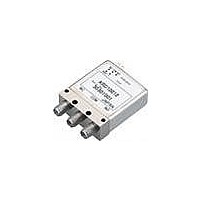ARD15105Q Panasonic, ARD15105Q Datasheet - Page 11

ARD15105Q
Manufacturer Part Number
ARD15105Q
Description
Coaxial Switches SPDT 5 VDC, 2
Manufacturer
Panasonic
Datasheet
1.ARD10012Q.pdf
(11 pages)
Specifications of ARD15105Q
Number Of Positions
2
Contact Form
SPDT
Termination Style
Solder Terminal
Frequency
18 GHz
Impedance
50 Ohms
Insertion Loss
0.5 dB at 18 GHz
Isolation
60 dB at 18 GHz
Terminal Pitch
3.5 mm
Vswr
1.5 at 18 GHz
Coil Voltage
5 VDC
Lead Free Status / Rohs Status
Lead free / RoHS Compliant
Available stocks
Company
Part Number
Manufacturer
Quantity
Price
Company:
Part Number:
ARD15105Q
Manufacturer:
FUZETEC
Quantity:
56 000
RD (ARD)
NOTES
1. Coil operating power
Pure DC current should be applied to the
coil. The wave form should be
rectangular. If it includes ripple, the ripple
factor should be less than 5%.
However, check it with the actual circuit
since the characteristics may be slightly
different. The nominal operating voltage
should be applied to the coil for more
than 50 ms to set/reset the latching type
relay.
Please use the latching type for circuits
that are continually powered for long
periods of time.
2. Coil connection
When connecting coils, refer to the wiring
diagram to prevent mis-operation or
malfunction.
3. Connection of coil indicator and
washing conditions
1) The connection of coil indicator
terminal shall be done by soldering.
Soldering conditions
Max. 260°C
10sec (soldering time)
Max. 350°C
3sec (soldering time)
2) This product is not sealed type,
therefore washing is not allowed.
4. Conditions for operation, transport
and storage conditions
1) Ambient temperature, humidity, and
atmospheric pressure during usage,
transport, and storage of the relay:
(1) Temperature:
–55 to +85°C
(2) Humidity: 5 to 85% RH
(Avoid freezing and condensation.)
The humidity range varies with the
temperature. Use within the range
indicated in the graph below.
(3) Atmospheric pressure: 86 to 106 kPa
Temperature and humidity range for
usage, transport, and storage:
2) Condensation
Condensation forms when there is a
sudden change in temperature under
high temperature and high humidity
conditions. Condensation will cause
deterioration of the relay insulation.
(Avoid freezing when
used at temperatures
lower than 0°C 32°F)
–55
–67
Tolerance range
500°F
662°F
–67 to +185°F
85
5
+32
0
(Avoid
condensation when
used at temperatures
higher than 0°C 32°F)
Humidity, %RH
Temperature, °C
(solder temp) within
(solder temp) within
°F
+185
+85
All Rights Reserved © COPYRIGHT Matsushita Electric Works, Ltd.
3) Freezing
Condensation or other moisture may
freeze on the relay when the temperature
is lower than 0°C 32°F. This causes
problems such as sticking of movable
parts or operational time lags.
4) Low temperature, low humidity
environments.
The plastic becomes brittle if the relay is
exposed to a low temperature, low
humidity environment for long periods of
time.
5) Low-temperature and low-humidity
atmosphere.
When exposed to low temperature and
low humidity for a long time, the relay’s
plastic casing may become breakable.
5. Other handling precautions.
1) The relay’s on/off service life is based
on standard test conditions (temperature:
15 to 35°C
75%) specified in JIS C5442-1996. Life
will depend on many factors of your
system: coil drive circuit, type of load,
switching intervals, switching phase,
ambient conditions, to name a few.
2) Use the relay within specifications
such as coil rating, contact rating and on/
off service life. If used beyond limits, the
relay may overheat, generate smoke or
catch fire.
3) Be careful not to drop the relay. If
accidentally dropped, carefully check its
appearance and characteristics before
use.
4) Be careful to wire the relay correctly.
Otherwise, malfunction, overheat, fire or
other trouble may occur.
5) The latching type relay is shipped in
the reset position. But jolts during
transport or impacts during installation
can move it to the set position. It is,
therefore, advisable to build a circuit in
which the relay can be initialized (set and
reset) just after turning on the power.
6) If a relay stays on in a circuit for many
months or years at a time without being
activated, circuit design should be
reviewed so that the relay can remain
non-excited. A coil that receives current
all the time heats, which degrades
insulation earlier than expected. A
latching type relay is recommended for
such circuits.
7) For SMA connectors, we recommend
a torque of 0.90±0.1 N·m for installation,
which falls within the prescribed torque of
MIL-C-39012. Please be aware that
conditions might be different depending
on the connector materials and how it
interacts with surrounding materials.
59 to
95°F, humidity: 25 to
8) Please do not use silicon based
substances such as silicon rubber, silicon
oil, silicon coatings and silicon fillings, in
the vicinity of the relay. Doing so may
cause volatile silicon gas to form which
may lead to contact failure due to the
adherence of silicon on the contacts
when they open and close in this
atmosphere.
9) Please note that when switching
contacts (latching type only), you must
apply reset (ALL) voltage and release all
contacts first. (SP6T type)
10) Do not use multiple contacts
simultaneously. (SP6T type)



